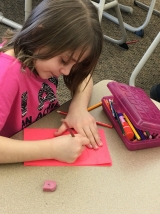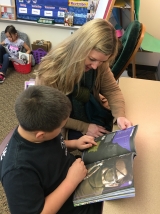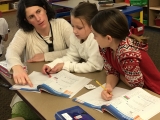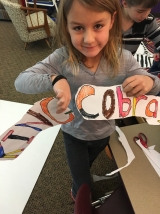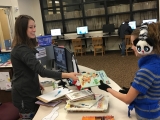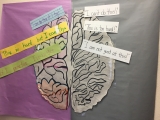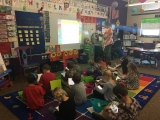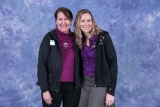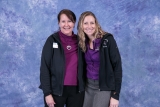-
Category 1
Selected in 2016
-
Grades: pre k - 5
School Setting: rural
Town Population: 18,288
Student Enrollment: 297
Student Demographics:
Black/African American: 1%
Teacher/Student Ratio: 1:16
White/Caucasian: 87%
Hispanic: 7%
Hawaiian/Pacific Islander: 0%
Asian: 1%
Native American: 4%
Other: 0%
% Reduced Lunch: 36%
% ELL Learners: 2%
Founded: 2009 -
PRINCIPAL:
Paige Sanders -
CONTACT:
1010 E. Woodland Park Rd.
Sheridan, WY 82801
307-674-7937
paige.sanders@scsd2.com
Woodland Park Elementary
Sheridan, WY
Culture can be described in one simple word: collaboration. We are constantly reflecting on ways to grow and improve as a staff, … through capacity building. Each year we start over in the hard and messy stages of change. We understand that this is…best for our students.
- Describe specific programs in place to ensure that families are involved in the success of your school and students.
- In addition to the samples provided in question 1. One of our greatest family and school connections is through our Parent Liaison. Our Parent Liaison helps bridge the gap between home and school. In addition to our Parent Liaison we strongly encourage family involvement at Woodland Park Elementary: Annual Read-a-Thon, Scholastic Book Fairs, Title I Family Nights, Literacy and Math Nights, Love and Logic Parenting Classes, Common Sense Parenting Class, Monthly PBIS Assemblies, Harvest Festival, Evening Parent/Teacher Conferences, Monthly PTO Meetings, After School Program and Tutoring, Monthly Newsletters, and Family Movie Nights.
- Describe the most successful activity your school has initiated to strengthen ties to your community.
- Through the use of our Next Level Program (Parent Liaison) and Professional Learning Communities we have focused on strengthening our ties with our community. With the help of our Leadership team we host several community events to inform and request information and feedback from our community members. Community involvement through: PTO; our fantastic After School Program; Build a Birdhouse event; Parent Engagement Night on Literacy, Math, technology and Title 1; and hosting professional speakers to talk about bullying, Bucket Filling and more, continues to strengthen our ties to our community. We value the involvement and input of all stakeholders and find this to be one of many ways we have grown as a school.
- Describe your philosophy of school change or improvement.
-
Since becoming a Model PLC School, we have found that change is always ongoing! Our motto at Woodland Park Elementary, for the past two years has been: “Change is hard at first, messy in the middle, and gorgeous at the end.” –Robin Sherma
There is no end. We are on a constant and ever-changing journey toward perfection, in a profession where perfection is not possible. Which is the beauty of it! We will not stop looking for ways to improve our impact on our students. We will never settle for our best, but always accept the challenge of doing better.
As our motto suggests, each year we start over in the hard and messy stages of change. We understand that this is not defeating or impossible, but healthy and what is best for our students. The power and acceptance of change would assist any school considering embarking on the PLC process. - What are your school’s top two goals for the next year?
- 100% proficiency in all academic areas for ALL students, along with supporting a Growth Mindset and the use of data notebooks to ensure we are empowering and inspiring everyone to reach their full potential.
- What is the single most important factor in the success of your school that others could replicate?
-
Becoming a PLC is one of the most important factors of our success. We build professional capacity using job-embedded professional development. At Woodland Park our mission is: A community that inspires and empowers everyone to reach their full potential and embrace: “Change is hard at first, messy in the middle, and gorgeous at the end.” –Robin Sherma
This is one of the most valuable insights we have gained on our complex journey toward an effective PLC. We have discovered that PLC is not a product, but a process, there is no end. We are on a constant and ever-changing journey and will not stop looking for ways to improve our impact on student learning. Each year we start over in the hard and messy stages of change. We understand that this is not defeating or impossible, but healthy and what is best for our students. The power and acceptance of change would assist any school considering embarking on the PLC process. Simply stated, PLC is not something we do, it is who we are. - Describe the program or initiative that has had the greatest positive effect on student achievement, including closing achievement or opportunity gaps, if applicable.
- Ensuring a guaranteed and viable curriculum for all students! We analyzed the four essential questions of a PLC. What we want our students to learn, how we know they are learning it, how we will respond when they already know it, and when they don't. Our grade level teams began unwrapping the standards vertically, discussing the evolution of the standards and how they complexify through the grade levels, developing student friendly " I Can" learning targets. Collectively we reflect on teaching strategies and student data. We evaluate our teaching strategies in a way that is consistent and comparable among classrooms, allowing for focused intervention and enrichment. We took two PLC fundamentals to heart: less is more and focus on proficiency, not coverage. We revised our common assessments, it was obvious how our expectations were pushing our students to achieve more! Looking at our state assessment data, our efforts are paying off and our students are demonstrating mastery!
- Explain how Title I funds are used to support your improvement efforts.
- Hattie states, “The greatest influence on student progression in learning is having highly expert teachers to maximize the effect of their teaching on all students in their care” (Hattie, 2015b). This research supports our philosophy of ensuring high levels of learning for all students, including our students who are served through Title I. The support initiative that we consider to be the most valuable for our students’ achievement lies in the foundation of effective personnel. We know that no program or website, both of which can aid a trained individual in supporting student learning, can replace the value of an effective educator. We not only consider our certified teachers essential in this initiative, but also our paraprofessionals who bear the responsibility of assisting in the preparedness of every student in our building. We choose to use as much of our funding as possible to hire, maintain, and train teachers and support staff.
- Identify the critical professional development activities you use to improve teaching and student learning.
- Job-embedded professional development. Through training with our Math Coordinator, Literacy Coordinator and Reading Recovery trained teachers, our Title I staff learns new research and effective practices. Watching videos of each other's lessons and providing feedback, professional book studies, and guided practice of techniques like running record analysis, are three of many learning opportunities we implement. Title I students are always being instructed at the cutting edge of their learning. It is our goal to utilize an apprenticeship approach to learning, allowing for our Title I students to make accelerated progress, closing the gap between them and their peers.
- Describe how data is used to improve student achievement and inform decision making.
- We use a triangulation of assessments to measure long-term progress. Fountas and Pinnell’s Benchmark Assessment informs our practice of the level our students are able to read independently. This allows us to validate our weekly monitoring and ensure independence and transfer of strategic processing. Weekly running records for our at-risk students, and monthly running records for our proficient and advanced students monitor the progression of our students’ reading levels. We utilize consistent expectations for accuracy, fluency, and comprehension to score these assessments. This provides a common language to ensure our students are meeting grade level expectations through common assessments, ensuring we support the complex text specified by the CCSS. These assessments MUST make a difference in student learning. A great deal of thought and collaboration contribute to the influence data has on student achievement. Every student should celebrate a year’s growth after a year’s input.
- Describe your school culture and explain changes you’ve taken to improve it.
- Our school culture can be described in one simple word: collaboration. The impact collaboration has on both student and adult learning is extremely high. We understand that collaboration is not enough. Our common weekly collaboration and systematic intervention and enrichment time does not impact student learning alone. What our teams collaborate about is what really makes the difference. We began with the four questions: What do we want students to learn? How do we know if they’ve learned it? What do we do they haven’t learned it? What will we do if they demonstrate proficiency? We are constantly reflecting on ways to to grow and improve as a staff, one way our staff is growing in collaboration is through capacity building with every staff member. These pieces and more; including ongoing celebrations and team building act., demonstrate our staff commitment to our mission, which truly makes Woodland Park a community that inspires and empowers EVERYONE to reach their full potential.
Stats
-
Category 1
Selected in 2016
-
Grades: pre k - 5
School Setting: rural
Town Population: 18,288
Student Enrollment: 297
Student Demographics:
Black/African American: 1%
Teacher/Student Ratio: 1:16
White/Caucasian: 87%
Hispanic: 7%
Hawaiian/Pacific Islander: 0%
Asian: 1%
Native American: 4%
Other: 0%
% Reduced Lunch: 36%
% ELL Learners: 2%
Founded: 2009 -
PRINCIPAL:
Paige Sanders -
CONTACT:
1010 E. Woodland Park Rd.
Sheridan, WY 82801
307-674-7937
paige.sanders@scsd2.com


